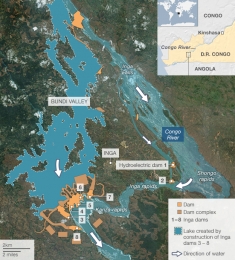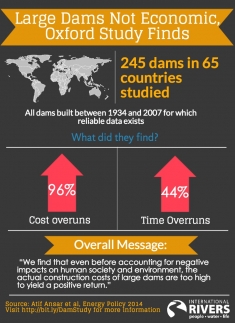World Bank Insists on Inga 3, Skips “Lessons Learned” from Past Big Dams
The Board of the World Bank’s International Finance Corporation will meet on March 20 to discuss technical assistance funding for the Inga 3 hydropower project in the Democratic Republic of Congo (DRC), after an earlier meeting was cancelled in February. The Board of Directors will consider a $73.1 million grant for carrying out technical, social and environmental impact studies, preparing the institutional groundwork, and carrying out a communication strategy for the project. Yet many questions about Inga 3’s suitability for meeting DRC’s energy needs and its economic viability remain, and civil society groups have many major concerns about the project.
The World Bank claims that Inga will be “one of the continent’s most cost-effective power sources” but the figures do not confirm this. The World Bank estimates the total cost for developing Inga 3 will reach $14 billion. Excluding likely cost overruns, the 4,755 megawatt project will cost $2,944 per kilowatt of capacity – much more than the International Energy Association’s estimated average cost of $1,278 per kilowatt for hydropower projects.
A recent study by researchers from Oxford University shows that on average, large dams have cost overruns of 96% and delays of more than 40%! This study, which analyzed 245 large dams built between 1934 and 2007 from 65 countries, studied their projected versus actual costs. It found that cost overruns are particularly high for poor countries such as the DRC. Indeed, the experience with the rehabilitation of Inga 1 and 2 and their transmission lines affirm the study's findings. The original costs for rehabilitating these projects were estimated to come to less than $200 million in 2003, but by 2013 the costs had skyrocketed to $1.2 billion with the project still to be completed. Yet the original completion date was set for 2007.
In a conversation with International Rivers, the Oxford study’s lead researcher, Dr. Atif Ansar, was very pessimistic about Inga 3. “It is a very high-risk project typical of dam disasters,” he said. Using the findings of the Oxford study to forecast cost overruns, he suggested the cost of Inga 3 should be budgeted for $28 billion instead of $14 billion to obtain 80% certainty that the budget is not exceeded. On scheduling, Dr. Ansar indicated that given the limited capacity for project management that exists in the country the Inga 3 is likely to have delays of about 60-80% beyond the planned schedule to reach completion. Given that the DRC’s gross domestic product in 2012 was only $17 billion, he commented, “It is insane for someone to put the total wealth of the country into one project. It is like one buying a house that exceeds all one’s projected lifetime earnings.”
It seems obvious that, despite its claims to the contrary, the World Bank has not learnt lessons from previous large dam development experiences. The Bank is turning a blind eye to the country’s poor governance and poor record of development outcomes for past projects. For example, from the funds that were released for Inga 1 and 2, $6.5 million disappeared unaccounted for. The risks are just too high to be ignored.
The World Bank also continues to neglect environmental risks. As we documented earlier, it is taking short-cuts to the assessment for the cumulative environmental risks of the Grand Inga scheme. At $1.4 million, the budget for the environmental baseline study and impact assessment is smaller than the $1.5 million budget for the communication plan for Inga 3. It seems the Bank plans to address projects risks and criticism with public relations rather than in-depth assessments.
Cheaper solutions for energy access exist, and we’ll continue to press the DRC and its donors to take them up. Unlike Inga 3 , these alternatives are more certain to deliver benefits directly to the DRC population. The Oxford study recommends adopting policies that reduce risk by choosing energy solutions that can be built in a shorter time, reducing schedule overruns, and in a case as the DRC, selecting alternatives that do not constitute a large chunk of the country’s financial resources.
We do hope that as the members of the World Bank Board sit to consider the technical assistance grant, they will look carefully at the track record of large dams, the track record of the DRC in developing similar projects and the capacity of the country to handle such a huge project. Most importantly, they should make a decision based on what type of energy development will best serve the DRC people directly.





